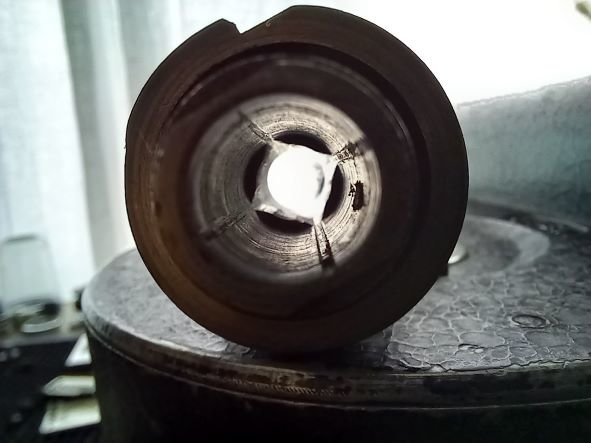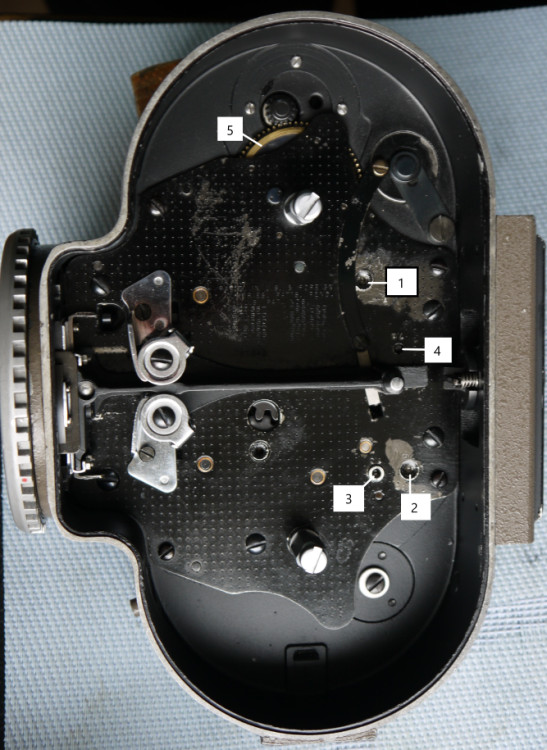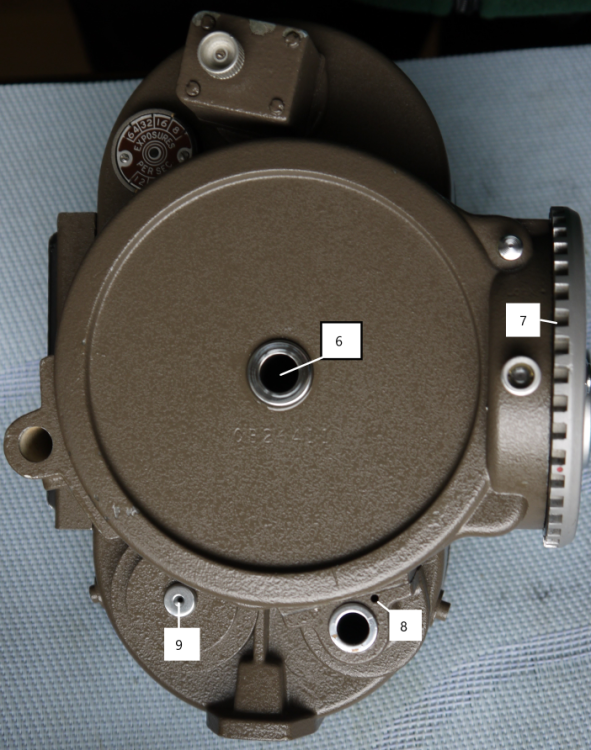-
Posts
2,588 -
Joined
-
Last visited
Everything posted by Simon Wyss
-
To find out more about the spring take the camera in your hands, lid off. Try to turn the winding key in both directions while observing the pair of gears through the round opening in the main plate. If the gears don’t budge, they might be stuck, pound together. Set speed dial to a low tempo, hold key firmly, and try to push the lower gear, the one nearer the base, inwards along its axis with a pin driver or such. You may want to help it by wiggling the key but do not let it go. If you can separate the gears and feel force on the key, a healthy spring is in place. Basically, the mechanism should run by spring force when the stop gears are separated.
-
Well done! I don’t know the polarity of the plug.
-
https://www.aircorpsdepot.com/cannon-connectors/?srsltid=AfmBOormlJFW281_DIOUJyBeMFxyo15HSJtv7SVAVsN1K3eyycRiC6aP
-
You can pull the winding key out, it should hold in the chromium plated bushing by its snap ring. After removal you will see more. To place the key back give it a smack with heel of hand. Thanks for the pictures. You have indeed a later DR or an HR, 1960s. The turret got swapped some time or worked on. The patent numbers say nothing about the date of manufacture. Some patents can have elapsed, know that parts were often made early and kept in chests. The patent numbers were embossed from the beginning, main plates used up over time. Although the best of all amateur cameras Filmo 70 were assembled in long series and at times fast. Leave the mechanism alone. As long as it works drop in oil and use the camera. These are the oiling points, nr. 7 means the centre of the turret where you pull out a plug. The speed dial can be stuck. Remove the curved arm for accessing the dial, not hard to disassemble, clean, lubricate, and reassemble. At the same time you will find out whether the governor can be adjusted by simply pushing and pulling the curved arm up and down.
-
Almost everything is possible. Number 17498 would be a Filmo from the first half of the twenties. If a body has no number, it can be understood that a special example is present. A spring missing is an other indicator of something peculiar and the 115 Volt motor finally tells I’m an indoor/studio/institute camera. The winding key not turning left must be on purpose. If only the spring was removed or left out, you could still turn the spring core (in wich sits the key) between the stops of the gears visible through a round opening just beneath the centre of the main plate. The body is obviously older than the lid. Why a DR lid is on remains to be explained. With a couple photos that show the RH side of the camera where the name plate is and the film compartment I could tell more.
-

What’s the origin of correctly exposed middle gray?
Simon Wyss replied to silvan schnelli's topic in General Discussion
Screen luminance is standardised. From the projection flux of light necessary for standard screen luminance the diffuse density of prints is derived as a middle grey. From the prints’ middle grey a negative middle grey or density is calculated. After the negative exposure is determined by the amount of light reaching it you have a given diaphragm opening for a given exposure time (shutter angle width, frame rate). The diaphragm opening determines the flux of light for taking pictures where a middle grey is deducted from snow white. Since the exposure index of a cinematographic material is given, say, ISO 100, the last variable is the luminance of a snow white or grey surface. We can choose between white as reference or grey. Sometimes checkerboard or printing dot greys are used. Development of negative and positive is standardised, too. -
As much as I know you won’t reach 24 fps with that Hulcher, maybe 12. You’re out in the woods with it, cinematography-wise. Certainly fun to watch the dog movement. I’m outta game here.
-
Yes. What 70 mm camera?
-
Sachtler Horizon Upper cases, a double name
- 3 replies
-
- tripod
- fluid head
-
(and 1 more)
Tagged with:
-

Bolex struggling for single frame shooting
Simon Wyss replied to Chloe Charlton's topic in General Discussion
Somebody taken off the I-T switch lever/knob? The derailleur is perhaps dislodged which would be the cause for the issue. To fix this the finder tube and the front must be removed. -

Digital Film Out to B&W Negative On 16mm
Simon Wyss replied to Scott Pickering's topic in Film Stocks & Processing
An aperture according to ISO 466 can have any width of 10,05 mm mininum and a height of 7,42 mm minus 0 plus 0,15 [0.396 in. × 0.292 in. minus 0 plus 0.006]. The concept of measurements of 16 mm is a 0.4 in. wide picture on film that is advanced by 0.3 in. The image diagonal is half an inch, normal focal length is double that. The aspect ratio is not defined. By tradition it’s 4:3 like with the standard film and 9.5 mm. 8 mm formats same 1:1,37(5) is the nominal aspect ratio of the 35 mm camera aperture as it was defined by the AMPAS in 1932, 0.868 in. × 0.631 in. That was altered to 0.867 × 0.630 a few years later. Today ISO 2906 gives 0.864 in. minimum × 0.630 in. minus 0 plus 0.02. The projected image shall have the 4:3 ratio since the agreement of the Paris congress of film producers of 1909 which is still in effect. It’s still possible to produce a silent or a sound movie and rely on the old standards. For the sake of interchangeability and copying among film sizes 4:3 is indicated. -
We must be cautious with history. The Moisson-Lumière-Carpentier apparatus advances the film by 20 mm, the image area has the size of 20 mm × 25 mm. The cinématographe has not become anything standard. It disappeared almost completely from the market in 1905 when the Lumière sold the entire project to Pathé frères. What survived from it was the two cams arrangement for the claw trajectory in the 1908 Pathé industriel and other machines. 1000 frames per minute was settled as universal speed at the 1909 Paris convention of film producers, under the survey of Georges Méliès.
-

faulty 16mm scan_ camera or dev/scan issue!?
Simon Wyss replied to david jenewein's topic in General Discussion
The possibility exists that the stock got exposed at the manufacturer’s plant, the more so, if it was never rewound. Would you confirm that the raw film was loaded into the camera directly from the original boxes? -

Adjusting Shutter and Pulldown Timing on Bolex REX 5
Simon Wyss replied to Alexander Boyd's topic in Bolex
There’s a little more to the timing of an H than only the claw-shutter cooperation. But I take that you won’t or haven’t disassemble/d the whole mechanism down to the mainspring, so you have just shutter and claw to adjust. If I may keep it simple, see that the mechanism is halted by the derailleur under force from the mainspring. Then lift the Nylon gear and set the claw gear so that the excentric post is in the lowest position. Put on the plastic gear while aligning it with its two bores parallel/perpendicular to the square lug of the 1-1 shaft. Put on drive cup to sit on the square and secure with screw. Next you put on the front section with the shutter in a position where both blades cover the aperture. Make sure both claws are turned back against their rests. Slowly lower the front and observe shutter, turret swivelled 180 degrees, reflex double prism swung out. Shutter should not turn far. Once in place, hold it there while pushing the side release knob to P(ICTURE), the single-frame functions switch set at T(IME). Shutter should stop with leading edge just above aperture, Paillard specified 1,5 mm. If not, repeat sequence until you’re near. If unsatisfactory, loosen the three set screws of the helical gear on shutter shaft, turn about 20 degrees, retighten. When like described turn in the front attaching screws, one may be the clamp with a nut on the inside. Before tightening the screws observe shutter while holding side release pushed to P and wiggling the front in the little room the screws allow. If still satisfactory, tighten all screws. To check set camera up, turn spring clutch lever to 0, at the same time lock side release at M(OTOR). Put rewind crank on 8-1 shaft (the one in axis with the frame counter’s singles knob) or on 1-1 shaft in case you have a straight pin in it. A RX-5 usually has the asymmetric hammer pin there for the synch motors. Pressure unit removed from camera and turret free observe cooperation between claw and shutter. That’s all. -

How does one print Ektachrome onto projection film?
Simon Wyss replied to Owen A. Davies's topic in Film Stocks & Processing
I find KODAK VISION Color Intermediate Film 3242, ESTAR base, in the Kodak motion-picture products price catalog for the United States, effective February 1, 2024. On page 21 are listed 16 mm × 2000 ft rolls perforated both edges and one edge, $1028.60 each.- 13 replies
-
- ektachrome
- kodak
-
(and 2 more)
Tagged with:
-

Travel Tripod Recommendation
Simon Wyss replied to Christian Flemm's topic in Camera Operating & Gear
Vibrations indicate an older model, do you happen to have a serial number below 100,400? Likeable that you project. My suggestion is to find a clamp that allows to attach a head with camera to a lamp post, a branch, a table, a wall. Way smaller than a tripod, versatile, you can even take two along. -
Cameras that offer a critical NON-REFLEX focusing finder 35 mm. Bell & Howell Standard 2709, Bell & Howell Eyemo 71-CA and younger models on focusing alignment gauge, Bourdereau Cinex, Caméréclair, Debrie Parvo L, Mitchell, and more 9½ mm. Paillard-Bolex H, ETM P (no rackover base known for both models) 16 mm. Bell & Howell Filmo 70-D and younger models on focusing alignment gauge, Paillard-Bolex H plus rackover accessory, ETM P, Keystone K-56 Executive (Kodak 50-ft magazine), Fearless, Mitchell, Maurer, Nord, Victor 3-4-5, Bach Auricon Pro-600, Auricon Super 1200 Double-Eight. Bell & Howell Filmo Eight Turret on focusing alignment gauge, Paillard-Bolex H, Cinekon Eight, Sankyo 8-R/RT, Zeiss-Ikon Movikon 8 aslant (direct view of image on film), Pentacon AK 8, Specto 88, Arco CR-8, Arco Eight 803 A, Canon 8-T, Bauer 8 and 88 with insert prism; prisms useable with many more cameras. Eumig C 3 view of image on film after lid modification DS-8. Only after-market conversions
-
The grainy surface belongs to the prism that’s critically set. To reach to it you need to unscrew the mounting ring on the magnifying elements. If you attempt to do that yourself, take care. Most often the lenses are dirty, not the prism. The shiny front surface of the prism is accessible.
-

faulty 16mm scan_ camera or dev/scan issue!?
Simon Wyss replied to david jenewein's topic in General Discussion
How long is the line? Could you tell the number of frames perhaps? -

faulty 16mm scan_ camera or dev/scan issue!?
Simon Wyss replied to david jenewein's topic in General Discussion
In the first picture I see no line. The film edge got light from loading or whatever. The line with the second picture makes me wonder about light hitting the film through a small hole somewhere in the camera body or a magazine The line with the third picture is in the same place but faint. My suggestions are: use a turret model with smaller, lightweight C-mount prime lenses. That’s what the turret is for. A clamp on the turret prevents it from lifting off. A locking screw (red lacquer circle) prevents the turret from rotating. I don’t understand why PL-mount lenses have to be put on an amateur camera. You’re not acting professionally by doing that, on the contrary, it’s against the rule to keep things simple use fresh film that was not respooled and if you do nonetheless, make sure you respool yourself have the camera and or magazine(s) seen after by a technician change lab -
An iris never vignettes. The diaphragm takes the place where its size changes the flux of light, the hole of the optics.
-
stricter comparative of strict which is a monosyllabic adjective
-

The Return of VistaVision
Simon Wyss replied to Gautam Valluri's topic in On Screen / Reviews & Observations
Simple. VV is based on 35-mm. film. The choice of labs and printing facilites is vaster than with wide film. The only bottleneck appears when you want to turn-copy the VV image to wide stock. That certainly is the reason for DI. -
The Single-8 cartridge is standardised. Nobody needs to feel ashamed to manufacture it or use it. The Kodakers still stick to the unfortunate coax cartridge from the sixties. Five and a half thousand dollars for a C-mount camera without a finder that lets you focus accurately is just bold. For that money a second-hand 35-mm. camera can be found, a wonderful tripod with a fluid head, couple lenses, and more, a complete outfit for CINEMA. Who cares for a plastic handle that can be screwed to a camera’s roof? I note a screaming discrepancy between crystal controlled frame rates and insecure image steadiness. The Eastman-Kodak Company once had participated in the 8-S cartrigde project that led to Single-8. Agfa, too. Jürgen Lossau described the history since 1959 in more depth. Of course are the gates of these Supa-8 cameras dirty, that’s an essential ingredient of the look.
-
Looks like pressure plate not correctly engaged and or loop(s) lost.






